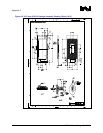
R
mPGA604 Socket Design Guidelines 33
6 Validation Testing Requirements
This section of the document outlines the tests that must be successfully completed in order for the
supplier's socket to pass the design guidelines validation. It provides the test plan and procedure
required for validation.
6.1 Applicable Documents
EIA-364-C.
Electrical Mechanical and Thermal Specification (EMTS)*
Thermal Design Guidelines Document*
Note: *For details on ordering this documentation, contact your Intel field sales representative.
6.2 Testing Facility
Testing will be performed by Intel's designated test facility.
6.3 Funding
Socket supplier will fund socket validation testing for their socket. Any additional testing that is
required due to design modifications will also be at the expense of the supplier.
6.4 Socket Design Verification
At the earliest possible date, a detailed drawing of the socket supplier's mPGA604 socket must be
provided to Intel for review. This drawing should include all of the features called out in this design
guideline (marking, pinout, cam location, date code location and explanation, etc.) as well as
dimensional and board layout information. This drawing will be used to confirm compliance to this
design guideline.
6.5 Reporting
Test reports of the socket validation testing will be provided directly from the independent test
facility to Intel. Intel will also be given access to contact the test facility directly to obtain socket
validation status, explanation of test results and recommendations based on the test results.
6.6 Process Changes
Any significant change to the socket will require submission of a detailed explanation of the change
at least 60 days prior to the planned implementation. Intel will review the modification and establish
the necessary re-validation procedure that the socket must pass. Any testing that is required MUST
be completed before the change is implemented.
Typical examples of significant changes include, but are not limited to, the following: Plastic
material changes including base material or color; contact changes including base material, plating
material or thickness; and design modifications.


















